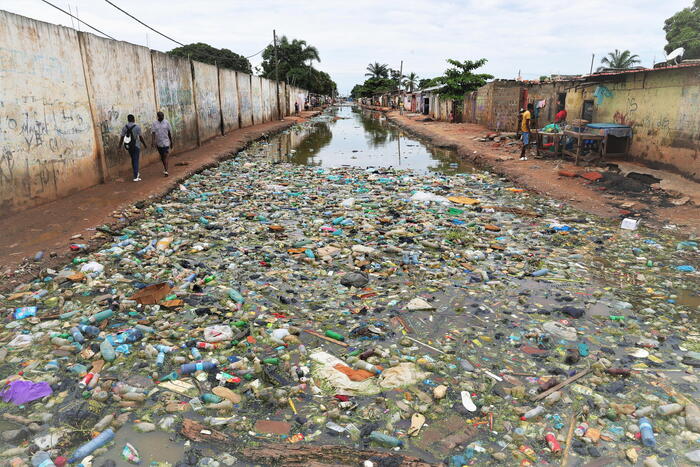How plastic pollution is transforming the planet
The UN is organizing this week in Paris a second phase of negotiations to reach an international, legally binding treaty against plastic pollution. Le Parisien retraces the "plastic routes" to the oceans and explains the extent of the environmental drama.
Read more
Environment
How plastic pollution is transforming the planet
The UN is organizing this week in Paris a second phase of negotiations to reach an international, legally binding treaty against plastic pollution. Le Parisien retraces the "plastic routes" to the oceans and explains the extent of the environmental drama.
Anissa Hammadi and Stanislas de Livonnière
Last update: 29/05/2023
Bottles floating on the surface of the water, turtles strangled by plastic bags... There is no shortage of shocking images to raise awareness of the devastating effects of plastic on the environment. It accounts for 85% of marine debris. But how do our packaging, bottles and bags end up at sea? What is their path? Le Parisien has traced the "roads" of plastic, or rather plastics, to the sea and the ocean.
To try to stop this environmental drama, the international community is meeting for a second session aimed at finding a global agreement to fight it, from Monday, May 29 to Friday, June 2 in Paris. Eventually, these negotiations could lead to a historic, legally binding treaty to eliminate plastic pollution.
Credits: Getty Images/iStockphoto
Plastic pollution: what are we talking about?
There are several types of plastic: macro (particles larger than 5 mm), micro (less than 5 mm) and nano (less than 0.001 mm). They all have very different physical behaviors, which scientists apprehend in parallel.
The different types of plastic
-
Le Parisien / Infographic
The different types of plastic
-
Le Parisien / Infographic
The different types of plastic
-
Le Parisien / Infographic
Everyone knows macroplastic: it is bottles, packaging, straw, cotton buds, etc. Once in nature, these objects break down into a multitude of microplastics.
Microplastic can be derived from the wear and tear of tires, textiles or objects (this is called secondary microplastic) or voluntarily added to cosmetics, cleaning products, paint, artificial grass (primary microplastic). They come in different forms: fragments, fibers, microbeads, films...
According to ANSES, they can be composed with more than 20 different polymers (polystyrene, polyethylene, etc.). They are everywhere in the air, water, soil, homes.
These microplastics are very worrisome, as the smaller ones are difficult to detect in the environment. Once at sea, it is almost impossible to recover them.
Plastic pollution in everyday life
Even if you live hundreds of miles from the ocean, the plastic waste you throw away often ends up in sewers, lakes or rivers, and can then move to the sea.
Sources of land-based pollution
-
Le Parisien / Infographic
Sources of land-based pollution
-
Le Parisien / Infographic
Sources of land-based pollution
-
Le Parisien / Infographic
Sources of land-based pollution
-
Le Parisien / Infographic
Sources of land-based pollution
-
Le Parisien / Infographic
Behind the term "urban pollution" we find all kinds of objects that are deteriorating: shoe soles, artificial lawns, paintings of buildings...
Scientists group them together because individually they contribute little to environmental pollution. But at the scale of a country, the accumulation of these microplastic releases is considerable.
In use, tires erode and lose particles composed of synthetic rubber. This tire dust is then dispersed by the wind or washed away by rainwater.
Here, the pollution results from the marking on the ground (composed of thermoplastics) which is damaged with the passage of cars. Exposed to bad weather, these microplastics are also dispersed by the wind or washed away by rainwater.
Like animals, wind can contribute to scattering garbage can waste on the road. On the coast, its role is even more important.
Depending on the city and country, here begins the ocean. In rainy weather, part of urban water is not treated: it is directly discharged into the environment, with the plastic potential it carries.
Microplastic, pollution undetectable by filters
Whether it's microbeads in an exfoliating cream or fibers that come off clothes in the washing machine, microplastics pass through wastewater and can easily end up in the ocean.
Microplastics at home
-
Le Parisien / Infographic
Microplastics at home
-
Le Parisien / Infographic
Many hygiene and cosmetic items contain plastic microbeads, which can account for up to 10% of the weight of the product. Their use discharges plastic particles directly into wastewater.
In France, these products have been banned since January 1, 2018, but they are sometimes imported.
During washing, the fibers of our clothes come off. Some are composed of microplastics, which wastewater treatment plants fail to filter. They therefore end up directly in waterways.
Some solutions recommended by the researchers are simple: wash your clothes less, avoid "fast fashion", favor second-hand and better woven pieces.
As of January 1, 2025, new washing machines will be required to have a filter to block plastic microfibers.
Watercourses, the main vector of pollution
Crossing agricultural land, industrial land or urban agglomerations, waterways carry the vast majority of plastic debris that ends up in the ocean.
In Southeast Asia, rivers particularly affected
A volunteer cleans up the Chao Praya River in Bangkok on December 21, 2018, to raise awareness of the ravages of single-use plastic. Reuters/Soe Zeya Tun
Some areas more affected than others, but a global responsibility
The Rio Las Vacas in Guatemala flows through an open dump. Alejandro Balan/dpa/Icon sport
Some areas more affected than others, but a global responsibility
Open dump near Jakarta. DASRIL ROSZANDI/AFP
Some areas more affected than others, but a global responsibility
Credits: Sea Cleaners
Some areas more affected than others, but a global responsibility
The path of plastic is often marked by prolonged strandings, especially in the Seine estuary. LP/Aurélie Foulon
Quantifying the exposure of watercourses to plastic pollution remains methodologically challenging. It is therefore very complicated to obtain uniform and robust figures. On the other hand, scientists have one certainty: rivers represent the main routes of plastic to the seas.
Barely 1000 rivers alone drain 80% of all macroplastic pollution to the oceans. They are mainly located in Southeast Asia and Africa, but also in South America.
But experts want to avoid stigma: "Southeast Asia is accumulating its own plastic production and waste from Europe and North America. Except that this region of the world does not have infrastructure as efficient as ours. The responsibility is collective," insists researcher Lisa Weiss.
Sea Cleaners has therefore designed a boat capable of collecting floating waste to clean Balinese waters, but also micro-waste for scientific purposes.
Why there? Because Bali is one of the most densely populated and polluted islands in Indonesia. Sea Cleaners estimates that 33,000 tons of waste flow into the Java Sea from the 372 Balinese rivers.
Contrary to popular belief, the road to the ocean is long and tortuous. At the end of a study on the Seine, researchers concluded that 100% of plastic waste ends up on a bank at one time or another, even those that float badly.
"It was a big surprise," recalls Romain Tramoy, co-author of the study conducted on the Seine. It is a continuous back and forth in the estuary. Hence the interest of intensifying the pick-ups on the banks, in a professional way. »
Using GPS, the researchers were able to track waste for one to two months. After a year of experiments, no object had reached the sea.
VIDEO. Trajectory of waste floating in the Seine
Even if the journey can take years, the destination is inescapable: the ocean.
The scourge of fishing nets
Lost, abandoned or discarded fishing devices, called "ghost gear", are very dangerous: they move with currents and trap all marine fauna in their path.
A problem
They are mostly lost, but they can also be abandoned or rejected. iStockphoto
A solution
CLS tag placed on a fishing net. CLS
Fishing gear (nets, ropes, cages and nylon lines) is the largest category of debris found on beaches and at sea in terms of volume.
To remedy this, the company CLS (Collecte localisation satellites) had the idea of placing beacons on fishing nets to find them in case of loss, before they sink too deeply.
"Searching for a lost net is too expensive," says Marc Lucas, oceanographer at CLS. Thanks to the beacons, you can ask the nearest boat to pick it up. »
Another source of pollution from ocean to ocean: boat coatings, certainly strong, anti-corrosion and anti-fouling, but stuffed with plastics of all kinds.
The risk of leaks
Containers carrying finished plastic products, such as take-out boxes, plastic toys and synthetic clothing, are sometimes lost at sea when they fall from cargo ships during transport. They then release hundreds or thousands of plastic items into the ocean.
Containers washed up on a New Zealand beach near Tauranga, January 9, 2012 after the sinking of the cargo ship "Rena". AFP/Marty Melville
Many plastics begin their life cycle in the form of industrial plastic pellets (IPGs). During their manufacture or transport (by truck, train or cargo), these primary microplastics can also be accidentally released into the environment in varying quantities.
VIDEO. A tide of plastic spreads in Sri Lanka
In May 2021, a cargo ship off the coast of Sri Lanka caught fire and eventually dumped several containers of IPG into the ocean. The accident wreaked havoc on local wildlife, nearby beaches and fishermen's activity.
The ways in which plastic ends up in the ocean are multiple, complex, sometimes invisible and unsuspecting. Once in the water, it is almost impossible to recover it, especially in the state of microplastic. That is why specialists advocate reducing its production.
Unfortunately, the world remains addicted to plastic: its annual production has more than doubled in 20 years to reach 460 million tons. It could triple again by 2060 if nothing is done. This means three times more plastic debris in the oceans, when there are already several thousand tons of it every year.
According to several researchers interviewed, the role of multinationals, such as Coca-Cola, is increasingly being singled out: pressure is intensifying for these companies to invest in the construction of recycling plants and wastewater treatment plants in the developing countries where they are located.


/cloudfront-eu-central-1.images.arcpublishing.com/prisa/NIFZFFYBFVAU5FVWDHC43ESC5M.jpeg)






